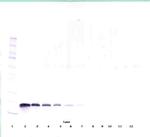Search Thermo Fisher Scientific
图: 1 / 3
VEGF-165 Antibody (500-P275BT-1MG) in WB



产品信息
500-P275BT-1MG
宿主/亚型
分类
类型
抗原
偶联物
形式
浓度
保存条件
运输条件
RRID
产品详细信息
AA Sequence of recombinant protein: MAPTTEGEQK AHEVVKFMDV YQRSYCRPIE TLVDIFQEYP DEIEYIFKPS CVPLMRCAGC CNDEALECVP TSESNVTMQI MRIKPHQSQH IGEMSFLQHS RCECRPKKDR TKPEKHCEPC SERRKHLFVQ DPQTCKCSCK NTDSRCKARQ LELNERTCRC DKPRR.
Preparation: Produced from sera of rabbits immunized with highly pure Recombinant Rat VEGF 165. Anti-Rat VEGF 165-specific antibody was purified by affinity chromatography and then biotinylated.
Sandwich ELISA: To detect Rat VEGF by sandwich ELISA (using 100 µL/well antibody solution) a concentration of 0.25-1.0 µg/mL of this antibody is required. This biotinylated polyclonal antibody, in conjunction with PeproTech Polyclonal Anti-Rat VEGF (500-P275) as a capture antibody, allows the detection of at least 0.2-0.4 ng/well of Recombinant Rat VEGF.
Western Blot: To detect Rat VEGF by Western Blot analysis this antibody can be used at a concentration of 0.1-0.2 µg/mL. Used in conjunction with compatible secondary reagents the detection limit for Recombinant Rat VEGF is 1.5-3.0 ng/lane, under either reducing or non-reducing conditions.
500-P275BT-1MG will be provided as 2 x 500 µg
靶标信息
The vascular endothelial growth factor (VEGF) family currently includes VEGF-A, VEGF-B, VEGF-C, VEGF-D, VEGF-E, and PIGF. VEGF and its receptor system have been shown to be the fundamental regulators in the cell signaling of angiogenesis. Most tumors have the absolute requirement of angiogenesis and VEGF has been described as the most potent angiogenic cytokine linked to this process. To date 5 different isoforms of VEGF have been described. These isoforms are generated as the result of alternative splicing from a single VEGF gene. These various isoforms have been shown to bind to two tyrosine-kinase receptors flt-1 (VEGFR-1) and flk-1/KDR (VEGFR-2), which have been found to be expressed almost exclusively on endothelial cells.
仅用于科研。不用于诊断过程。未经明确授权不得转售。



